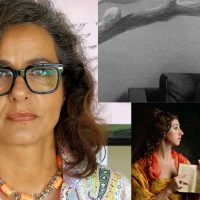Angelika Rinnhofer: Photographer, Conceptual Artist

I first met South Florida artist Angelika Rinnhofer while I was viewing the exhibition of her “a priori” project at FIU’s Miami Beach Urban Studios on Lincoln Road. I thought I was the only person in the gallery, as I took the time to consider each photo and video carefully, and understand the powerful content of “a priori.”
Suddenly I became aware that I was not alone. A beautiful woman was standing by a white sculpture pedestal that served as a desk-top, silently writing in large, elegant, loopy letters on big (24 x 18 inch) sheets of vellum. I confirmed that the writer was Angelika Rinnhofer. She was transcribing video/audio interviews onto the sheets of vellum, and each time she filled in a page she tacked it onto the gallery wall within previously completed transcriptions, creating beautiful translucent “time funnels” (my term) to accompany photos and videos of the interviewees.
What totally captured my attention and imagination was Rinnhofer’s story about the inspiration for the “a priori” project. Although born, raised Catholic, and educated in Germany, Rinnhofer had married an American Jew and moved to New York City. Somewhat sheepishly she told me that her first job was working for Donald Trump – but I won’t go down that rabbit hole.
Years later, while living near Beacon, NY, Rinnhofer had a powerful dream about her first boyfriend’s mother. Although Rinnhofer had not communicated with her first boyfriend (Peter) in over 30 years, the dream compelled her to track him down and call. Like old friends, they chatted for 30 minutes, catching up on one-another’s lives, when Peter suddenly announced that he had recently learned that he is from a Jewish family from Northern Germany. Not only was his family Jewish, but his grandfather had been an admiral in Hitler’s navy, possessing a falsified Aryan passport, which was signed by his immediate superior.
Thus “a priori” was born.
“a priori” is an art project which takes its title from Kant’s theory of “synthetische Urteile a priori”, judgments independent of experience and synthetic in nature. Rinnhofer refers to Kant’s terms of epistemology and correlates them to her participants’ experience of detecting family secrets. Their stories of discovery, often accompanied by archival data, evoke Kant’s exploration of the origin and structure of knowledge, especially his concept that synthetic judgments a priori contain the condition of every possible experience.
Rinnhofer records narratives of individuals, whose attempts to make sense of memories, stories, and facts eventually leads to the disclosure of their Jewish heritage. She takes photographs and videos of her participants and interviews them about their discoveries.
Rinnhofer sifts through the implications of her participants’ discoveries and tries to reveal the effect that anecdotes of trauma and separation have on one’s sense of self. The discovery of a family secret, often conceived out of necessity and passed on from generation to generation, carries the potential for revision and melioration. The effects of such revelations on her participants’ lives vary greatly. Rinnhofer documents these disclosures and postulates their potential to transform.
As a German artist who immigrated to the US, Rinnhofer has been exploring her own transformation while adapting to life in America. The effect that her chosen community has had on her life and art, all the while considering her upbringing in another culture, has prompted questions based in sociological discourse. With “a priori”, its catalyst in Germany’s history, and its focus on Jewish identity, Rinnhofer explores the dynamics of communities and the role of the individual in their midst.
Angelika Rinnhofer was born in Nuremberg, Germany and grew up surrounded by the visual opulence of Catholic churches in Bavaria. She spent church services in fearful awe, absorbing the images of tortured saints and martyrs that lined the walls. It was an unforgettable experience that she now draws upon as an artist. Trained as a photographer in Germany, and prior to the “a priori” project, Rinnhofer started posing people in bygone costumes, in postures, lighting, and composition inspired by the Old Masters. Not tied to the visual language of just one painter or one period in time, the photographs are heavily inspired by Albrecht Dürer, Michelangelo, and Caravaggio, as well as by Mannerism and the Renaissance.
The videos below are organized by topic and run between 30 seconds and 6 minutes. Click on any video. You must be connected to the Internet to view the videos.
EXPOSURE TO BROAD INFLUENCES: 1:12 min.
EDUCATION: 1:26 min.
SEIZES OPPORTUNITIES: 0:26 sec.
INSIGHT & INSPIRATION: 1:34 min.
EXPOSURE TO BROAD INFLUENCES: 1:49 min.
INSIGHT & INSPIRATION: 1:41 min.
DEVELOPING A VOICE: 1:55 min.
INSIGHT & INSPIRATION: 5:26 min.
CRITICAL THINKING: 4:20 min.
CREATES A UNIQUE PERSONAL BRAND: 1:17 min.
INSIGHT & INSPIRATION: 2:14 min.
EMPATHY: 2:58 min.
INSIGHT & INSPIRATION: 1:06 min.
UNDERSTANDS THE AUDIENCE’S PERSPECTIVE: 0:56 sec.
COMMUNITY VALUES: 3:57 min.

